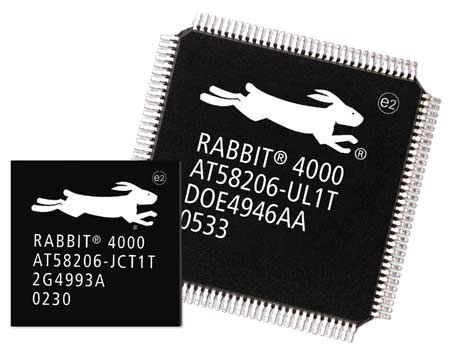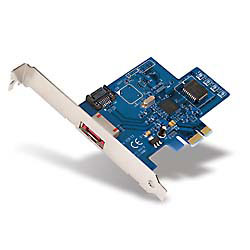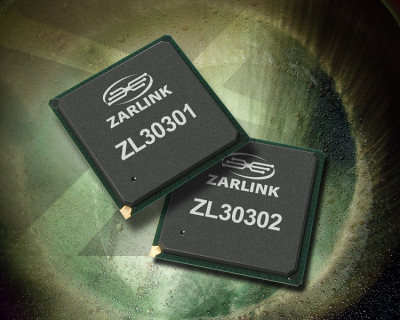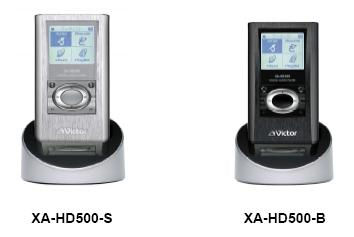 |
||
|
||
| ||
Rabbit Semiconductor Announces the New Rabbit 4000 Microprocessor TI And Airbee Deliver Ultra Low Power, Free 4-Node Zigbee Solution Belkin Unveils New PCI Express Cards Zarlink Introduces ToP Devices JVC To Release Alneo XA-HD500 Digital Audio Player Rabbit Semiconductor Announces the New Rabbit 4000 Microprocessor Rabbit Semiconductor announced the Rabbit 4000 as the newest addition to the Rabbit line of low-EMI microprocessors. The Rabbit 4000 like its predecessors is designed specifically for embedded control, communications, and Ethernet connectivity.  Building upon the Rabbit 3000, the Rabbit 4000 is offered in two RoHS compliant packages, 128-pin TQFP and 128-pin TFBGA configurations. The new features include integrated 10Base-T Ethernet, DMA, 16-bit memory device support, page-mode memory device support, and memory enhancements with physical address space of up to 16 MB. It also features hardware security features, hardware breakpoints, improved I/O, and variable-phase PWM. 500 new instructions have been added to increase the processing speed and efficiency. Programming the Rabbit 4000 microprocessor is simple with the Dynamic C software development system. It is accomplished by connecting an interface cable from a PC to a Rabbit-based target system. Software development and debugging can be performed over Ethernet/Internet using appropriate accessory hardware or RabbitSys. The Rabbit 4000 will be available in quantity March 2006.
TI And Airbee Deliver Ultra Low Power, Free 4-Node Zigbee Solution Helping speed ZigBee and 802.15.4 compliant systems to market, Texas Instruments Incorporated announced the availability of Airbee Wireless’ ZNS-Lite, ZigBee-ready networking stack software for the MSP430 platform of ultra-low power microcontrollers (MCUs). ZigBee’s wireless, standards-based radio technology addresses the needs of remote monitoring, control and sensor network applications including home control and awareness, building automation, industrial automation, asset management and homeland security. Based on the MSP430F161x MCU with a Chipcon 802.15.4 radio for receiving and transceiving, TI’s reference design will also include an example application note and PCB layout files. The free 4-node ZNS-Lite software for MSP430 devices will be available via the Airbee Wireless website at www.airbeewireless.com. The software stack includes a “getting started” guide and a programmer’s reference manual. A full version of the Airbee ZNS (protocol stack) software can be purchased directly from Airbee. A hardware evaluation board (DZ1612) is also available from SoftBaugh Inc. with Airbee’s ZNS-Lite Zigbee software pre-programmed on an MSP430F1612 MCU and also includes a Chipcon CC2420 transceiver and PCB antenna. DZ1612 evaluation boards can be purchased today for $199 at www.softbaugh.com.
Belkin Unveils New PCI Express Cards Belkin unveiled a number of new PCI Express Cards, which add expansion ports to your computer using new PCI Express technology. They will be shipping in North America in September 2005.  F5U197
Belkin’s full line of upgrade cards allow you to add Serial ATA, FireWire, or USB 2.0 ports to your computer through the new PCI Express slot. The Cards are designed to take advantage of the additional bandwidth and features provided by the new PCI Express I/O interconnection standards.
Zarlink Introduces ToP Devices Zarlink Semiconductor introduced its new generation of ToP (Timing-over-Packet) devices specifically designed to transmit timing and synchronization over asynchronous packet switched networks - ZL30301 and ZL30302. ToP technology is built on a field-proven processing engine developed for Zarlink’s CESoP (Circuit Emulation Services over Packet) family of devices. The ToP technology encodes a PRS (primary reference source) clock at the “master” node and subsequently transmits this clock over the packet network within a specific packet connection. The “client” node then recovers the clock through the use of complex algorithms employing a number of field-proven techniques.  For wireless infrastructure applications, the ZL30302 chip acts as the master and distributes the PRS from the RNC (radio network controller) to the Node B over an Ethernet network. At the Node B, the ZL30301 device acts as the client, extracting timing from the packet network and creating an output clock traceable to the PRS. Redundancy is also achieved, with the ZL30301 chip recovering up to four separate PRS clocks and selecting one for use within the client node. Both ToP devices support differential clock recovery, a mechanism used when the same PRS is available at both the master and client nodes, for example through a SONET infrastructure. The devices also support adaptive clock recovery, which is commonly used at the edge of the network where a PRS is usually available only at the master node. The ZL30301 and ZL30302 devices maintain an average frequency accuracy of less than +/- 15 ppb (parts per billion) with a Stratum 3 quality TCXO (temperature controlled crystal oscillator). Manufacturers are also using the PDH (plesiochronous digital hierarchy) G.823 and G.824 Traffic & Synchronization Interface standards as guidelines for packet network timing performance. In the event of network failure or severe network congestion, the devices will put recovered clocks into holdover until the flow of timing packets is restored. Zarlink’s ZL30301 and ZL30302 ToP devices are available only to qualified customers.
JVC To Release Alneo XA-HD500 Digital Audio Player On November 1 JVC is going to release the new Alneo XA-HD500 digital audio player featuring JVC’s K2 technology and the "studio tuning" for high fidelity reproduction of compressed music files. The XA-HD500 has a built-in 1" 6GB hard drive and is capable of approximately 30 hours of continuous playback.  Other features:
Write a comment below. No registration needed!
|
Platform · Video · Multimedia · Mobile · Other || About us & Privacy policy · Twitter · Facebook Copyright © Byrds Research & Publishing, Ltd., 1997–2011. All rights reserved. |